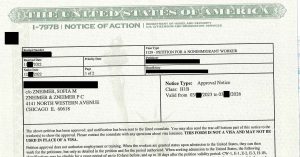The O-1A visa is designed for individuals with extraordinary ability in the sciences, education, business, or athletics. To qualify for an O-1A visa, applicants must demonstrate that they have achieved a level of expertise that is significantly above that of their peers in their field. At Zneimer & Zneimer, our experienced immigration attorneys can help you navigate the O-1A visa application process and analyze each criteria to determine if you qualify.To qualify for an O-1A visa, applicants must meet at least three of the following criteria:
- Documentation of the beneficiary’s receipt of nationally or internationally recognized prizes or awards for excellence in the field of endeavor;
- Documentation of the beneficiary’s membership in associations in the field for which classification is sought, which require outstanding achievements of their members, as judged by recognized national or international experts in their disciplines or fields;
- Published material in professional or major trade publications or major media about the beneficiary, relating to the beneficiary’s work in the field for which classification is sought, which must include the title, date, and author of such published material, and any necessary translation;
- Evidence of the beneficiary’s participation on a panel, or individually, as a judge of the work of others in the same or in an allied field of specialization for which classification is sought;
- Evidence of the beneficiary’s original scientific, scholarly, or business-related contributions of major significance in the field;
- Evidence of the beneficiary’s authorship of scholarly articles in the field, in professional journals, or other major media;
- Evidence that the beneficiary has been employed in a critical or essential capacity for organizations and establishments that have a distinguished reputation; or
- Evidence that the beneficiary has either commanded a high salary or will command a high salary or other remuneration for services, as evidenced by contracts or other reliable evidenc
The first criteria for O-1A visa eligibility is receipt of nationally or internationally recognized awards or prizes for excellence in the applicant’s field of endeavor. This criterion is one of the most straightforward ways to demonstrate extraordinary ability, as it provides concrete evidence of the applicant’s achievements and recognition within their field.
To meet this criterion, the award or prize must be significant and widely recognized within the applicant’s field of endeavor. This can include awards or prizes from government agencies, professional associations, or other reputable organizations. It is important to note that the award or prize must be based on the applicant’s individual accomplishments and not on the achievements of their Continue reading →




